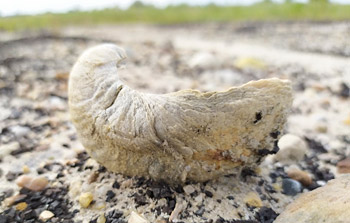
Electronic english version since 2022 |
The newspaper was founded in November 1957
| |
|
Number 36 (4633) |
JINR scientists studied fossil mollusc shells change
Staff members of the Laboratory of Neutron Physics JINR in collaboration with colleagues from the Borissiak Paleontological Institute of the Russian Academy of Sciences and the Tula Regional Museum of Local Lore have identified features of the crystallographic texture of minerals in fossil shells of molluscs. The findings would enable scientists to understand better how extinct molluscs were organized and lived about 165 million years ago.
For the second summer in a row, members of this research group go on expeditions to collect shells of various molluscs in order to study their crystallographic texture.
Crystallographic texture is the distribution of crystal orientations in the object under study. The team of scientists mainly studies the texture of shells of fossil and modern molluscs and other animals, such as corals and brachiopods. Recently, special attention has been paid to the shells of the Jurassic bivalve Gryphaea dilatata Specialists sought to describe the burial conditions of the samples and reconstruct the living conditions of extinct animals and plants in order to understand how different factors influenced the crystallographic texture. No studies on comparing the shell texture of organisms from different locations have been carried out before that.
 |
| Fossil shells of the Jurassic bivalve Gryphaea dilatata |
Scientists collected samples of fossil molluscs in the Tver, Tula, and Orel Regions. The samples were prepared and sent to FLNP JINR. "In Russia, only the Laboratory of Neutron Physics JINR is able to measure the crystallographic texture of objects using the neutron diffraction method. This method gives a broader picture of the crystallographic texture of the whole shell, whereas other methods only give an image of the small surface areas' texture. Neutron diffraction is gaining popularity in other countries, but it is still very rarely used for such purposes," Alexey Pakhnevich stressed. Studies were carried out at a SKAT texture diffractometer of the IBR-2 Research Reactor at JINR. In addition, the samples were examined by X-ray diffraction at FLNP and X-ray microtomography at the Paleontological Institute. This allowed scientists to determine the mineral composition of the shells and to check how the orientations of the calcite crystals are distributed in them.
Over millions of years in rock strata, many mollusc shells may have been altered or replaced by other minerals. Therefore, the participants of the study also wanted to understand how the crystallographic texture might have been affected. The texture has been found to be unchanged in almost all the samples taken, including molluscs aged around 165 million years. Neither habitat nor burial conditions of these organisms have influenced the texture. This indicates that crystallographic texture is a stable parameter, and scientists can rely on it to understand how organisms were arranged on a crystalline level millions of years ago. External conditions - pressure, temperature, depth of animal life - have not affected them.
Scientists are going to study the issue further to see if this conclusion is plausible. Therefore, Alexey Pakhnevich, together with his colleague Dmitry Nikolaev, FLNP Senior Researcher, have already set off on yet another expedition, this time to the Yaroslavl Region. Scientists are going to select samples to study the crystallographic texture of fossil nacre, cephalopod molluscs, so-called ammonites, and other molluscs.
Another striking result of the collaboration is the discovery of recrystallization of the shell surface layer of one of the samples. This is the only case of change in texture and microstructure of mollusc shells in the group's study and the first ever found in a crystallographic texture study.
"The recrystallization observed in the crystallographic texture allows us to approach the question of changes in the shell matter over millions of years from another perspective," the study participants noted. "We saw how recrystallization is reflected in the crystallographic texture. Finding this effect will also help to clarify whether the shell's mineral texture has been preserved over millions of years in its original state, as it was when the mollusc was alive."
A scientific paper is published based on the results of this research on the crystallographic texture of calcite in the shells of the fossil mollusc Gryphaea dilatata from different parts of the habitat, preserved under different burial conditions. The joint expedition activity has been also covered by the Paleontological Institute.
www.jinr.ru